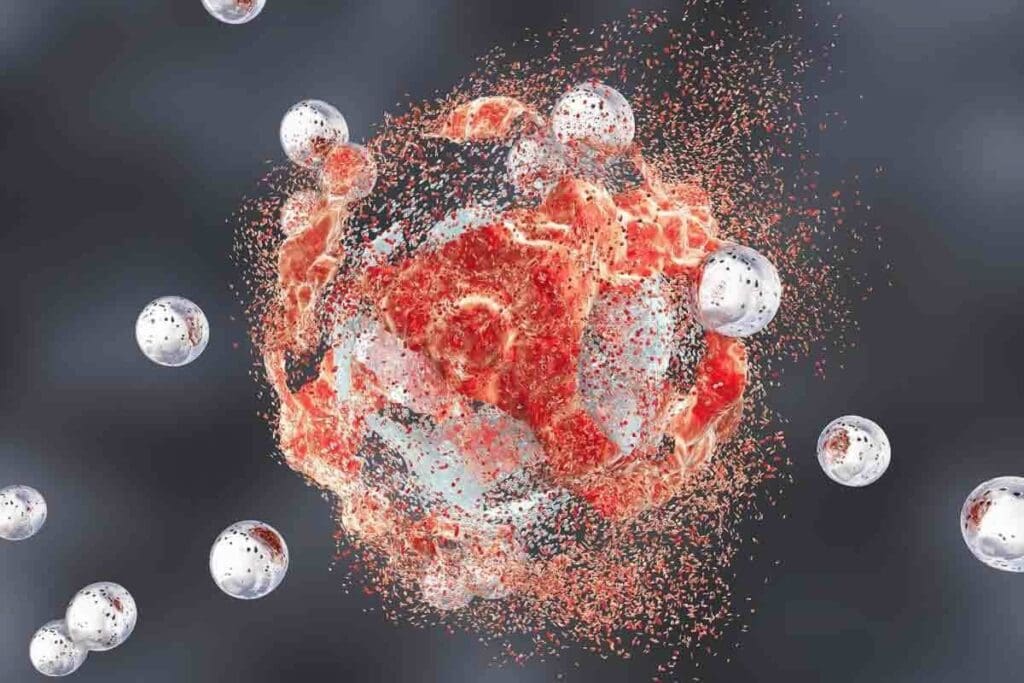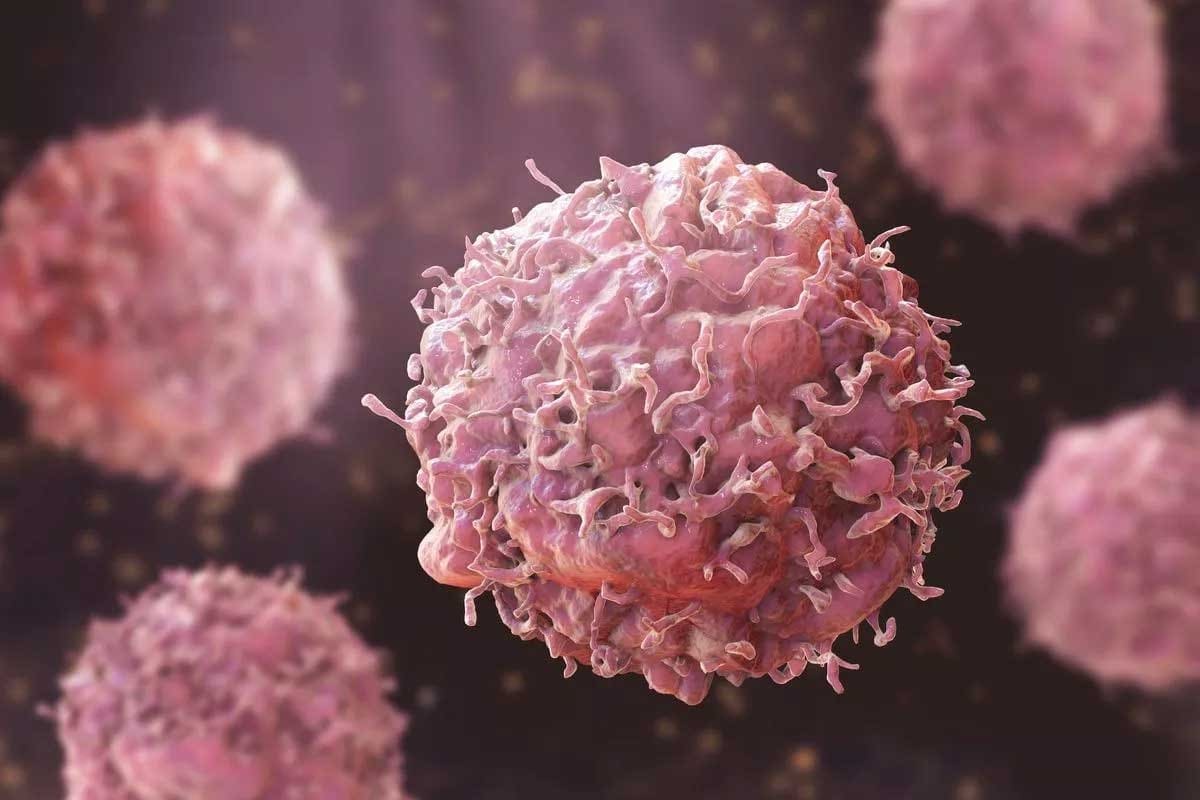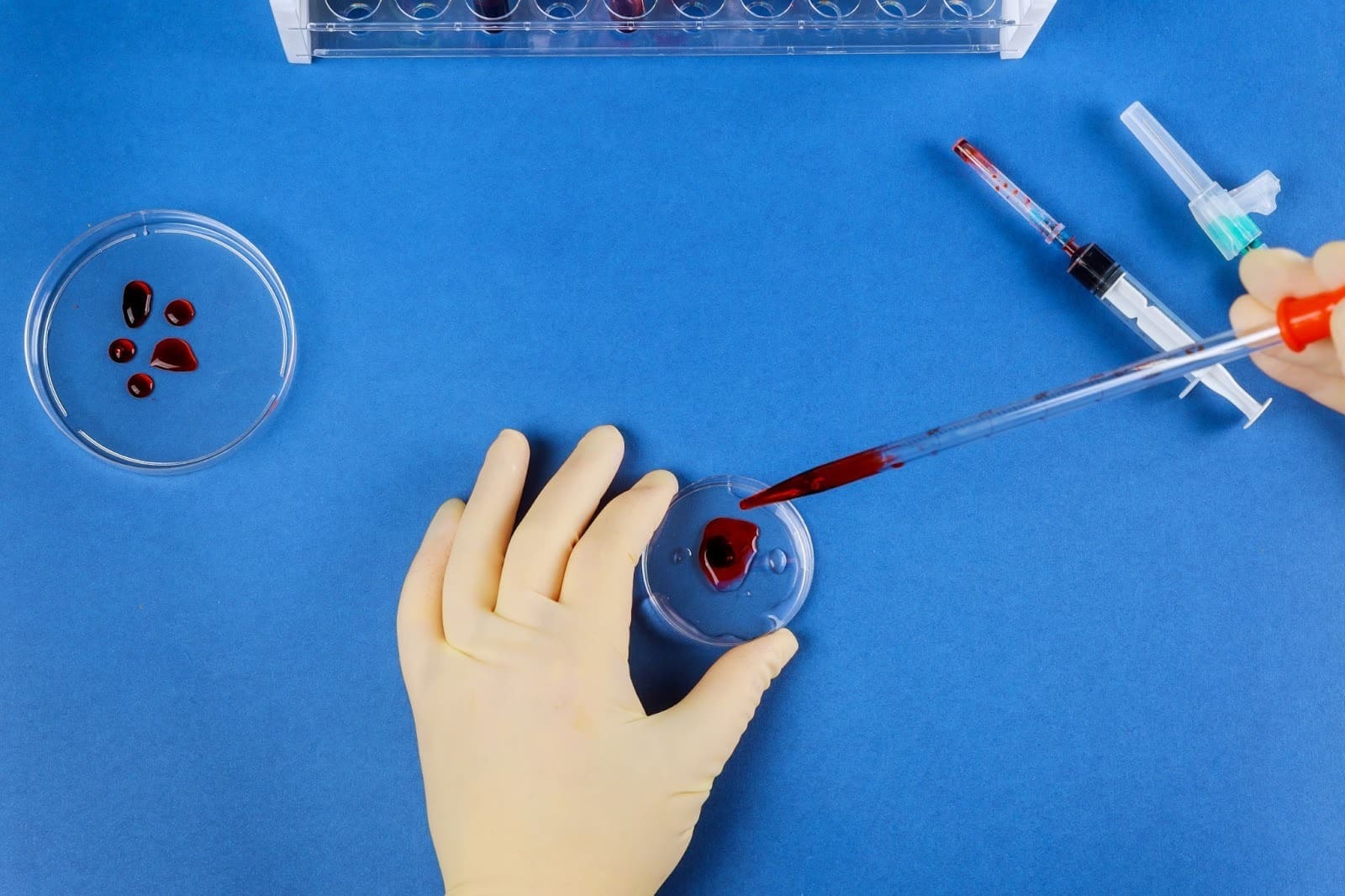Last Updated on November 27, 2025 by Bilal Hasdemir

At Liv Hospital, we understand how vital cancer treatment and radiation therapy are. Radiation therapy is a precise method that uses high-energy radiation to destroy cancer cells by damaging their genetic material, preventing them from growing and dividing.
We use targeted high doses of radiation to effectively destroy cancer tumors while minimizing impact on healthy tissues. Our team is dedicated to providing top-notch healthcare, offering full support and guidance to international patients.
Understanding how radiation therapy works helps patients see how this treatment can destroy cancer and improve health outcomes. At Liv Hospital, we focus on combining expertise with compassionate care to maximize treatment success.
Key Takeaways
- Radiation therapy targets cancer cells with high-energy radiation.
- It damages the genetic material of cancer cells, stopping their growth.
- Effective in treating tumors and improving patient outcomes.
- Crucial component of cancer treatment.
- Liv Hospital provides world-class radiation therapy with international support.
The Power of Radiation Therapy in Modern Cancer Treatment

Radiation therapy is a key part of modern cancer treatment, giving hope to millions. About 50 to 60 percent of cancer patients get radiation therapy. This shows how important it is in fighting cancer.
Radiation therapy is a strong tool against cancer and its symptoms. It can cure cancer, stop it from coming back, or slow it down. Its ability to treat cancer makes it a vital part of care.
What Is Radiation Therapy and How Common Is It?
Radiation therapy uses high-energy particles or waves to kill cancer cells. It targets cancer in a specific area of the body. Studies show it’s used in more than half of all cancer treatments
The Science Behind Radiation’s Cancer-Fighting Abilities
Radiation therapy works by damaging cancer cells’ DNA, stopping them from growing. When cancer cells can’t divide, they die. “Radiation therapy is a highly effective treatment for many types of cancer,” experts say.
Knowing about radiation therapy and its use in cancer treatment helps patients. It shows how it can greatly improve cancer outcomes.
How Radiation Works to Destroy Cancer at the Cellular Level

Radiation therapy is effective because it targets and damages cancer cells’ DNA. This damage causes the cells to die and stops them from dividing. This is key in stopping cancer cells from growing and spreading.
Targeting Cancer Cell DNA
Radiation damages cancer cells’ DNA, stopping them from growing and dividing. It does this through direct and indirect damage. Direct damage breaks DNA strands, while indirect damage comes from free radicals that harm DNA.
This damage is very effective against cancer cells. They often can’t fix their DNA like healthy cells can. So, cancer cells die because they can’t repair the damage.
Why Cancer Cells Are More Vulnerable Than Healthy Cells
Cancer cells are more vulnerable to radiation for a few reasons. They divide faster than healthy cells, making them more sensitive. Also, cancer cells often can’t fix their DNA well, making them even more vulnerable.
- Cancer cells divide quickly, making them more sensitive to radiation.
- Impaired DNA repair mechanisms in cancer cells increase their vulnerability to radiation damage.
- The chaotic nature of cancer cell DNA makes it harder for them to recover from radiation-induced damage.
By targeting cancer cells’ DNA, radiation therapy is a powerful treatment for many cancers. Understanding how radiation affects cancer cells helps us see its importance in cancer treatment today.
Types of Radiation Therapy in Cancer Treatment
The type of radiation therapy used depends on several factors. These include the cancer type, tumor size, and patient health. We use different approaches to tailor treatment to each patient’s needs.
External Beam Radiation Therapy
External beam radiation therapy (EBRT) is the most common type. It directs high-energy beams from outside the body to target and destroy cancer cells. EBRT is given over several sessions, allowing healthy cells to recover between treatments.
Internal Radiation Therapy (Brachytherapy)
Brachytherapy places radioactive material directly inside or near the tumor. This method delivers a high dose of radiation directly to cancer cells. It minimizes exposure to healthy tissues nearby.
Systemic and Intravenous Radiation Therapy
Systemic radiation therapy uses radioactive substances that travel through the bloodstream. It targets cancer cells throughout the body. Intravenous radiation therapy is a form of systemic therapy where the radioactive material is given through a vein.
We consider many factors when choosing the right radiation therapy for a patient. By understanding the different types, we can offer personalized care that meets each patient’s unique needs.
Way 1: DNA Damage – Breaking Cancer’s Genetic Blueprint
Radiation therapy targets cancer cells’ genetic material. It causes DNA damage, leading to cell death. This is key to treating many cancers.
Radiation therapy harms the DNA in tumor cells, making them die. It stops them from dividing. This happens through two main ways.
Direct and Indirect DNA Damage Mechanisms
Radiation can damage DNA directly or indirectly. Directly, it breaks DNA strands. Indirectly, it creates free radicals that harm DNA. Both ways cause genetic mutations or cell death.
Why Cancer Cells Struggle to Repair Radiation Damage
Cancer cells often can’t fix DNA damage well. This makes them more vulnerable to radiation. When radiation damages their DNA, they can’t fix it. This leads to cell death.
We use radiation therapy to target cancer cells’ genetic blueprint. It stops their growth and spread. This method is vital in fighting cancer, giving us a strong tool for treating tumors.
Way 2: Cell Cycle Disruption – Halting Cancer’s Reproduction
Radiation therapy targets the cell cycle to stop cancer cells from reproducing. The cell cycle is how cells grow, copy their DNA, and split into two. Cancer cells grow fast and out of control, making them weak to radiation.
How Radiation Affects Different Phases of the Cell Cycle
Radiation therapy impacts various cell cycle phases, like G1, S, G2, and M. The G2 phase is most sensitive to radiation. This is when cells get ready to divide. Radiation can damage DNA, stopping cancer cells from dividing.
Targeting Rapidly Dividing Cancer Cells
Cancer cells that grow quickly are more harmed by radiation. Radiation therapy attacks these cells in their active phases. This kills cancer cells while protecting healthy ones.
| Cell Cycle Phase | Effect of Radiation Therapy |
| G1 Phase | Cells are preparing for DNA replication; radiation can cause DNA damage. |
| S Phase | DNA replication occurs; radiation can cause DNA strand breaks. |
| G2 Phase | Cells prepare for mitosis; radiation can prevent cells from entering mitosis. |
| M Phase | Cells undergo mitosis; radiation can cause cell death during division. |
Way 3: Oxidative Stress – Using Free Radicals to Destroy Cancer
Oxidative stress is key in how radiation therapy kills cancer cells. Radiation creates reactive oxygen species (ROS), or free radicals, in tumors. These molecules harm cells, causing cancer cells to die.
The Critical Role of Oxygen in Radiation Effectiveness
Oxygen makes radiation therapy more effective. It helps free radicals damage cancer cells more. This is why radiation works better in well-oxygenated tumors.
How Free Radicals Damage Multiple Cancer Cell Components
Free radicals from radiation therapy harm different parts of cancer cells. They damage DNA, proteins, and cell membranes. This damage stops cells from working properly and leads to cell death.
| Cellular Component | Damage Caused by Free Radicals |
| DNA | Genetic mutations and DNA strand breaks |
| Proteins | Protein degradation and loss of function |
| Cell Membranes | Lipid peroxidation and membrane disruption |
Understanding oxidative stress helps us see how radiation therapy works. It shows how this treatment kills cancer cells.
Way 4: Tumor Microenvironment Modification – Changing Cancer’s Habitat
Radiation therapy does more than just kill cancer cells. It also changes the area around the tumor. This area, called the tumor microenvironment, is key to how cancer grows. By changing this space, radiation therapy makes it harder for tumors to survive and grow.
Effects on the Blood Vessels Supplying the Tumor
Radiation therapy affects the blood vessels that feed the tumor. It damages the cells lining these vessels. This damage cuts off blood flow and nutrients to the tumor.
This can lead to:
- Less new blood vessel formation
- Blood vessels are becoming more leaky
- Lack of oxygen in the tumor
These changes hurt the tumor’s ability to grow and live. An oncologist at the Institute of Research says, “Radiation therapy changes the tumor microenvironment. This can help fight cancer in ways beyond killing cells.”
“The tumor microenvironment is a critical determinant of cancer progression and treatment response. Modulating this environment through radiation therapy offers new avenues for improving cancer treatment outcomes.” – Professor of Radiation Oncology
Immune System Activation Following Radiation Treatment
Radiation therapy also boosts the immune system’s fight against cancer. It releases signals that tell the immune system to attack. This process involves:
| Immune Response Component | Effect of Radiation Therapy |
| Tumor Antigen Release | Increased antigen presentation to immune cells |
| Cytokine Production | Enhanced cytokine release, promoting immune activation |
| Immune Cell Infiltration | Increased infiltration of immune cells into the tumor |
By changing the tumor microenvironment, radiation therapy makes it hard for cancer cells to thrive. It also boosts the body’s natural defense against cancer. This shows how effective radiation therapy can be in fighting cancer.
Way 5: Apoptosis Induction – Triggering Cancer Cell Suicide
Radiation therapy uses a strong method to fight cancer. It induces apoptosis, or programmed cell death, in cancer cells. This helps get rid of cancer cells without harming healthy ones nearby.
Apoptosis is a complex process. It involves changes in cells that lead to their own destruction. In cancer treatment, making tumor cells die through apoptosis is a main goal.
The Cellular Pathways Leading to Programmed Cell Death
The process of apoptosis starts with a series of molecular events. These events can be set off by many things, like DNA damage from radiation. When radiation hurts the DNA of cancer cells, it can start the cell death process.
How Radiation Activates These Self-Destruction Mechanisms
Radiation therapy causes a lot of DNA damage in cancer cells. This damage starts a chain of events that leads to the activation of caspases. Caspases are enzymes that carry out the cell death program. So, radiation therapy makes cancer cells kill themselves, helping to get rid of them.
Way 6: Cellular Senescence – Forcing Cancer Cells into Permanent Retirement
Radiation therapy can destroy cancer by making cells stop growing forever. This is called cellular senescence. It stops cancer cells from dividing and growing more.
Understanding Radiation-Induced Senescence
When cancer cells get radiation, they can’t divide anymore. This is called radiation-induced senescence. Senescent cells look and work differently. They can’t grow but stay active.
Long-term Benefits of Senescent Cancer Cells
Senescence from radiation has big benefits. Senescent cells can stay in the body and stop tumors from coming back. They also change the area around the tumor, making it harder for cancer to return.
| Benefits | Description |
| Permanent Cell Cycle Arrest | Prevents cancer cells from dividing and growing |
| Altered Tumor Microenvironment | Makes it less conducive for cancer recurrence |
| Prevention of Tumor Regrowth | Senescent cells remain, preventing tumor regrowth |
Understanding and using cellular senescence makes radiation therapy a key weapon against cancer.
Way 7: Bystander Effect – Radiation’s Ripple Effect Beyond the Target
Radiation therapy does more than just target cancer cells. It has a ripple effect, thanks to the bystander effect. This happens when cells not directly hit by radiation are affected by signals from nearby cells that were.
How Treated Cancer Cells Affect Their Neighbors
Cancer cells exposed to radiation send out signals. These signals can harm or kill nearby cells that weren’t directly hit. This complex communication involves the release of cytokines and reactive oxygen species.
The Extended Impact of Radiation Beyond the Treatment Field
The bystander effect makes radiation therapy more effective. It reaches beyond the treated area. This can help get rid of tumors more thoroughly, even in cells that have spread.
| Mechanism | Description | Impact on Cancer Cells |
| Intercellular signaling | Release of cytokines and other factors from irradiated cells | Damage or death of neighboring unirradiated cells |
| Reactive oxygen species | Production of ROS in irradiated and bystander cells | Oxidative stress leading to cell death |
| Immune system activation | Stimulation of anti-tumor immune responses | Enhanced tumor control and possible abscopal effects |
Understanding the bystander effect helps us improve radiation therapy. We can make it more effective against tumors.
Conclusion: Advancing the Fight Against Cancer Through Radiation Therapy
Radiation therapy is key in fighting cancer. It helps destroy cancer cells and ease symptoms. By knowing how it works, we can see its strength in battling this disease.
It targets cancer cell DNA and disrupts their cycle. It also causes oxidative stress and changes the tumor environment. These actions show how radiation therapy fights cancer in many ways.
As we keep improving cancer treatment, radiation therapy is essential. It helps cure, prevent, or slow cancer growth. Using radiation therapy, we can make treatments better and improve patients’ lives.
FAQ
What is radiation therapy?
Radiation therapy is a treatment for cancer. It uses high-energy particles or waves to kill cancer cells. This helps shrink tumors and ease symptoms.
How does radiation therapy work?
It targets cancer cell DNA, damaging it. This stops cancer cells from reproducing and kills them.
What are the different types of radiation therapy?
There are several types. External beam radiation therapy sends beams from outside the body. Brachytherapy places radioactive material inside the body. Systemic radiation therapy includes intravenous therapy.
Does radiation therapy cure cancer?
It can cure cancer, depending on the type and stage. Or, it can help manage symptoms and improve life quality.
How does radiation therapy affect healthy cells?
It targets cancer cells but can harm healthy cells too. Yet, healthy cells can usually repair themselves better than cancer cells.
What is the role of oxygen in radiation therapy?
Oxygen is key. It helps create free radicals that damage cancer cells.
What is the bystander effect in radiation therapy?
The bystander effect is when radiation therapy affects cells outside the treatment area. It can kill more cancer cells.
Can radiation therapy be used in combination with other cancer treatments?
Yes, it’s often used with surgery and chemotherapy. This boosts its effectiveness.
How does radiation therapy induce apoptosis?
It triggers pathways that lead to programmed cell death. This kills cancer cells.
What is targeted radiation therapy?
It’s a type that targets cancer cells directly. This reduces harm to healthy tissue.
Does radiotherapy shrink tumors?
Yes, it can shrink tumors by killing cancer cells. This reduces the tumor size.
What is the definition of radiation treatment?
Radiation treatment, or therapy, uses high-energy particles or waves. It destroys or damages cancer cells.
References:
- Traub-Weidinger T, Lonsdale MN, Gil-Nagel A, et al. EANM practice guidelines for the appropriate use of PET and SPECT in epilepsy. Eur J Nucl Med Mol Imaging. 2024;51(7):1891-1908. https://pubmed.ncbi.nlm.nih.gov/38393374/






